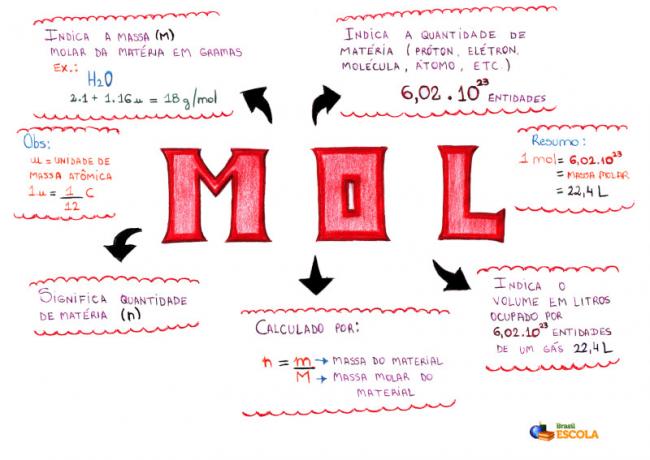O oxidation number (nox / Nox) corresponds to the ion's actual electrical charge, ie, the number of electrons the atom actually lost or gained during a chemical reaction.
This occurs during redox reactions, which involve the transfer of electrons between atoms, ions or molecules. An example of such a reaction is combustion.
Thus, we have two different concepts for oxidation and reduction:
- Oxidation: loss of electrons and increased oxidation number.
- Reduction: electron gain and oxidation number reduction.
Elements tend to gain, share or lose electrons in order to become stable, that is, to have eight electrons in the valence shell.
The concept of oxidation number is related to the electronegativity, that is, the tendency of the atom of the element to attract electrons when attached to another atom. For example, metals are slightly electronegative, while non-metals are quite electronegative.
How to determine the Oxidation Number?
The oxidation number varies with each chemical element. To find out the oxidation number of a chemical element, there is a set of rules that must be followed:
1. Nox of simple substances
the nox of each atom in a simple substance it is always equal to zero. This is because there is no electronegativity difference between the elements.
Examples: Fe, Zn, Au, H2, O2. All these elements have nox equal to 0.
2. Nox of monoatomic ions
The oxidation number of a monoatomic ion is always equal to its own charge. Examples:
K+ = + 1
F- = - 1
N-3 = - 3
Learn more, read also:
- Chemical reactions
- ion, cation and anion
- Valencia layer
3. Compound ion nox
In compound ions, the sum of the Nox of the elements that make up the ion is always equal to its charge.
The sum of the Nox of all constituent atoms of an ionic or molecular compound is always zero.
In the case of hydrogen in its compounds, the oxidation number is always +1, except when metal hydrides occur, where the nox is -1.
In the case of oxygen in its compounds, the oxidation number is -2. The exception occurs with oxygen fluoride (OF2), where nox is +2, and in peroxides, where nox is -1.
4. Elements with fixed nox
Some elements have fixed Nox in the compounds they are part of.
| Family / Elements | Nox |
|---|---|
| Alkali metals (1A) and silver (Ag) | +1 |
| Alkaline earth metals (2A) and zinc (Zn) | +2 |
| Aluminum (Al) | +3 |
| Fluorine (F) | -1 |
Exercises
1. (FGV - SP) Given the following chemical species: H2S, SO2, H2ONLY4, H2ONLY3 and S8, we can say that the oxidation number of sulfur (S) in these substances is, respectively:
a) +2, +2, +6, +6, -2
b) -2, +4, +6, +4, 0
c) +2, +4, +4, +6, -2
d) +2, +4, +4, +4, 0
e) -2, +2, +6, +4, 0
b) -2, +4, +6, +4, 0
2. (UFSCar - SP) The sulfur oxidation numbers in H2S, S8 and on2ONLY3 are, respectively:
a) +2, -8 and -4.
b) -2, zero, and +4.
c) zero, -4 and +3.
d) +1, -2 and -3.
e) -6, +8 and -5
b) -2, zero, and +4.
3. (PUC - MG - 2006) The oxidation number (NOx) of an element quantifies its oxidation state. What is the Nox of Cr in the Cr anion2O72-?
a) +3
b) +5
c) +6
d) +7
c) +6
4. (PUC - RS - 2003) The oxidation number of the carbon atom in CH structures4, HCHO and CO32- is, respectively:
a) +4 0 -4
b) -4 0 +4
c) 0 +4 -4
d) -4 -4 0
e) +4 +4 -4
b) -4 0 +4


